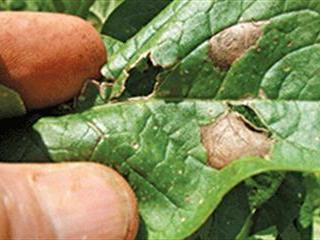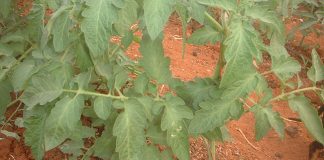
The lesions are about 10mm in diameter. However, the disease isn’t only confined to the leaves – it will also develop on stems, forming oval lesions. It’s particularly damaging when it girdles the stems of young plants and causes ‘collar rot’. In addition, early blight attacks the fruit, starting on the stem end near the calyx, and rendering the tomatoes unmarketable.
The spores are wind blown, and the disease will be more of a problem if an infected land is close by. But in my experience you’ll always get the disease when conditions are right whether there’s an infected crop nearby or not. Early blight can develop on a number of weeds and is a serious problem for potato growers too. It can also survive on crop debris for a year. In other words, in regions where the climate is suitable for the disease, there will never be a shortage of spores in the air.
Outdoor disease
Early blight is typically an ‘outdoor disease’, as water is needed for the spores to germinate and take root. For this reason those who grow tomatoes under plastic are unlikely to have a problem. Powdery mildew, on the other hand, doesn’t require water for the spores to germinate and is a big problem under plastic protection. Alternaria spores will germinate in half an hour and then require a further three to 12 hours of free moisture to take root. Much will depend on the temperature, which is ideal at 25°C to 29°C.
Heavy, prolonged dews are also sufficient for the disease to take hold, especially within the optimum temperature range.
Rain splash, wind and even workers attending to the crop will ensure that the spores are disseminated. In favourable conditions, symptoms may start to develop two to three days after infection. At this stage, if, say, the air is dry and sunny with little or no dew and rain, the disease will slow down or stop until the onset of favourable conditions once again.
As is often the case with fungal diseases, early blight tends to start on the older leaves. These are weakened as the plant concentrates all its attention on the younger developing foliage and fruit. By the same token, weak or stressed plants are also more vulnerable. Pruning the lower leaves will certainly help. In addition, this will change the microclimate near the soil, making conditions less favourable in this vulnerable region.
Early blight has to be controlled as yield losses will be proportionate to the degree of infestation. It’s not just about the amount of leaf area which is unable to function, but also the plant being stressed as it tries to fight off the disease.
Spray programme
In vulnerable areas, adopt a spray programme that will protect the foliage before the onset of symptoms. Use products that completely cover the foliage and protect the surface from spores germinating. These aren’t systemic products – they work on contact.
Systemic products aren’t used for prevention as resistance to them builds up, reducing their effective useful lifespan. You need to retain such products for use as ‘silver bullets’ in emergencies. Dithiocarbamates and copper products are usually used as preventive sprays. They need to be well sprayed so as to cover all surface areas in order to be effective.
Dithane M45 and copper can be combined if left to stand mixed for at least half an hour before application. These two products enhance one another, making the combination more effective than each alone. It’s always advisable to discuss your spraying programme with a knowledgeable chemical representative with experience of conditions in your area. They’ll also be able to recommend the best systemic product to use in an emergency.
Contact Bill Kerr at [email protected]. Please state ‘Vegetable production’ in the subject line of your email.












